The story behind the development of “Tec-Tec Life,” a map game born of grand ambitions.
Friday's Collecting Genjin, Part 5: "Going to Paint a Map with Kazuya Asano, Game Designer of "Tec-Tec Life"" (Japanese only)
Collections are interesting. While it is fun to see a substantial collection gathered around a particular theme, it is even more interesting to hear about people who are crazy about collecting. In this series, we will visit various collectors and collect episodes related to their collections.
Why do people collect things? What lies beyond collecting? Friday’s Collecting Originals” is a collection file that collects collectors.
There is a game called “Tech Life” that uses the location information of a smartphone. The only thing you have to do is fill in a map of the places you have actually walked around with your phone. It’s a fun game. The game was created by Kazuya Asano, known for “Kamaitachi no Yoru” and the “Mystery Dungeon” series.
He came up with the idea for this game based on his experience when he moved from Hyogo to Tokyo, where he actually walked around Tokyo with a map book and used markers to fill in the areas he stepped on. So, as well as showing us the map book in question, we walked around the city with Mr. Asano – and found out what he had to say.
Is painting a map book a collection or not?
─ ─ I think that collecting is not only about collecting things.
Asano Ah, I see. But it’s quite a change to feature my map book painting in this series, isn’t it?
─ ─ Well, yes. However, I myself really liked “Tech-Tech Life,” and the act of painting out the map has what I consider to be the “pleasure of collecting. Because the accumulation of one’s own actions is being stored as a record. So when I saw “Tec-Tec Life,” I thought, “This is a game for me! I thought to myself, “What a great idea!
Asano Thank you for that (laughs).
─ ─ I heard that the game design was based on the map book painting that Mr. Asano actually did with a map book in his hand. I came to Fuchu today to experience it. So you have already painted all of the 23 wards?
Asano: Yes, that’s right. Also, on the west side of Tokyo, I have painted most of Mitaka and most of Chofu, but I have never been to Fuchu because I had no business there.
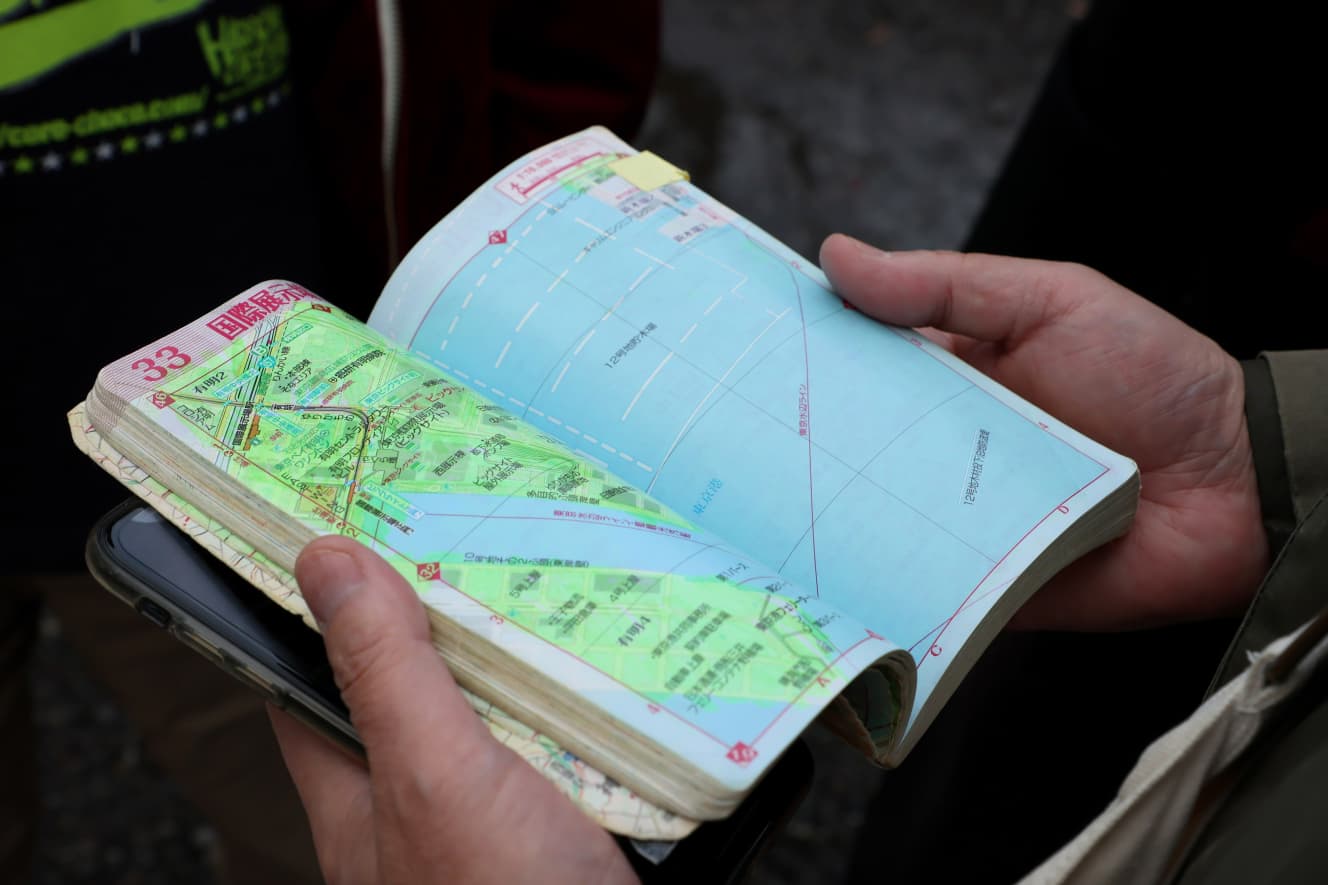
Well, Fuchu is a big place.
Asano: In Fuchu, there is the Okunitama Shrine not far from the station, so let’s go there. As for filming, I think we can get a good picture by filming me playing “Ingress” (see below), the shrine in the background, and then painting the map book.
─ ─ Thank you for even making a plan for the shoot (laughs). So, let’s talk with Mr. Asano as we walk towards Okunitama Shrine.
I wanted to walk all over Tokyo.
─ After graduating from university, you moved from Hyogo Prefecture to Tokyo, didn’t you? Was that to get a job at Chunsoft?
Asano: No, I did not come here because I had found a job, but because I wanted to make games. But I didn’t know what to do to make games. At the time, there were no game schools, and I didn’t really understand the game industry itself.
I liked “Dracula,” so I wrote and called Enix and said, “I would like to become a game creator if given the chance. When I said something like that, a very kind producer told me to come visit if I wanted.
─ That was back when the frontiers of the game industry were still wide open, or the entrance to the industry was still free.
Asano: I found out later that Enix was still just a desk, not much more than a company at the time. In the meantime, I thought I had to go to Tokyo anyway, so I started job hunting in Osaka, but then I looked for a branch office in Tokyo, or a place where I could transfer to. I was a liberal arts major, but I thought that if I was going to make games, I should have some knowledge of programming, so I joined a company that dealt with computer software.
─ That was not a game company?
Asano: Yes. I could have found a job outside of a game company. I entered a relatively good company that offered to pay for my move to Tokyo, and I spent some time training in a suit for a while. I happened to have a friend from junior high school over here who knew about my situation, so he read in a magazine that a company called Chunsoft was looking for a game designer. That was when I first learned that Chunsoft was making “Dracula.
─ ─ Well, at that time I did not understand the concept of a developer or a publisher.
Asano: So I applied for the job and was hired, and that was my entrance into the game industry.
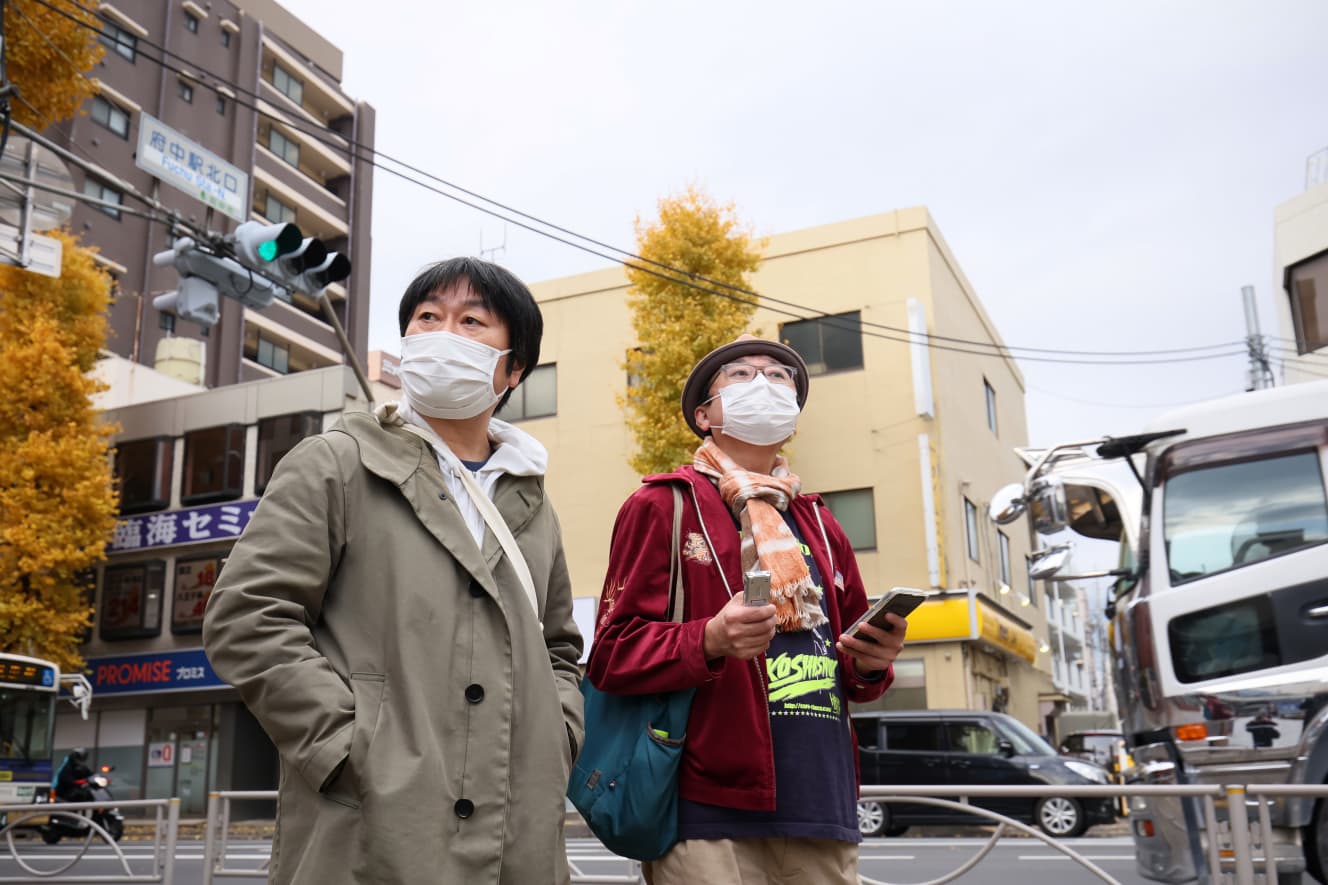
─ So when you came to Tokyo, you thought, “I want to walk all over Tokyo.
Amano: I want to walk all over Tokyo, or how should I put it, Tokyo is a kind of travel for me. It’s not my hometown. Everywhere I go, there are always unusual things to see. But the question is, what does it mean to go to all of them? I don’t know what to do.
─ ─ In another interview, you said that you “didn’t understand the game system.
Asano: Yes, that’s right. I didn’t know what constituted exhaustion. The first thing I came up with was a station system, but a station is a point. So, even if I arrived at the station and walked around in a circle, it would not make sense to me.
─ ─ In the world of railroad fans, there is a game called “rideshopping. So you were aware that there was a clear difference between that and what you wanted to do.
Asano: They are completely different. I felt that rules such as, “If you look around the station at all four corners, that part is OK,” were also different. In the end, I gave up because I felt it was impossible. I couldn’t come up with any rules, and it would be impossible to walk all the roads at once.
─ ─ It is very typical of game designers to stick to the rules.
To continue enjoying “Ingress
─ ─ You have found the rules, haven’t you, by starting to paint the map book in earnest after having given up on it? For example, in “Tech Life,” there is a circle that indicates 30 meters around you, and you can paint the city block within the area it touches. But in the actual act of painting a map book, there is no such thing as a circle, so what kind of rules do you have in place?
Asano: That’s a long story, so to put it simply, the rule is that if you hack all the “Ingress” portals in a certain area, you can paint that area as if you had been there.
*Here is an explanation of “Ingress” for those who do not know. Ingress” is the original location-based game that uses the GPS function of smartphones, and players choose to be either an Enlisted (green) or Resistance (blue) agent. They then walk around a map that is linked to a real map and take up positions by hacking points called portals (historical sites, monuments, statues, stations, churches, shrines, and other strongholds) located throughout the country.
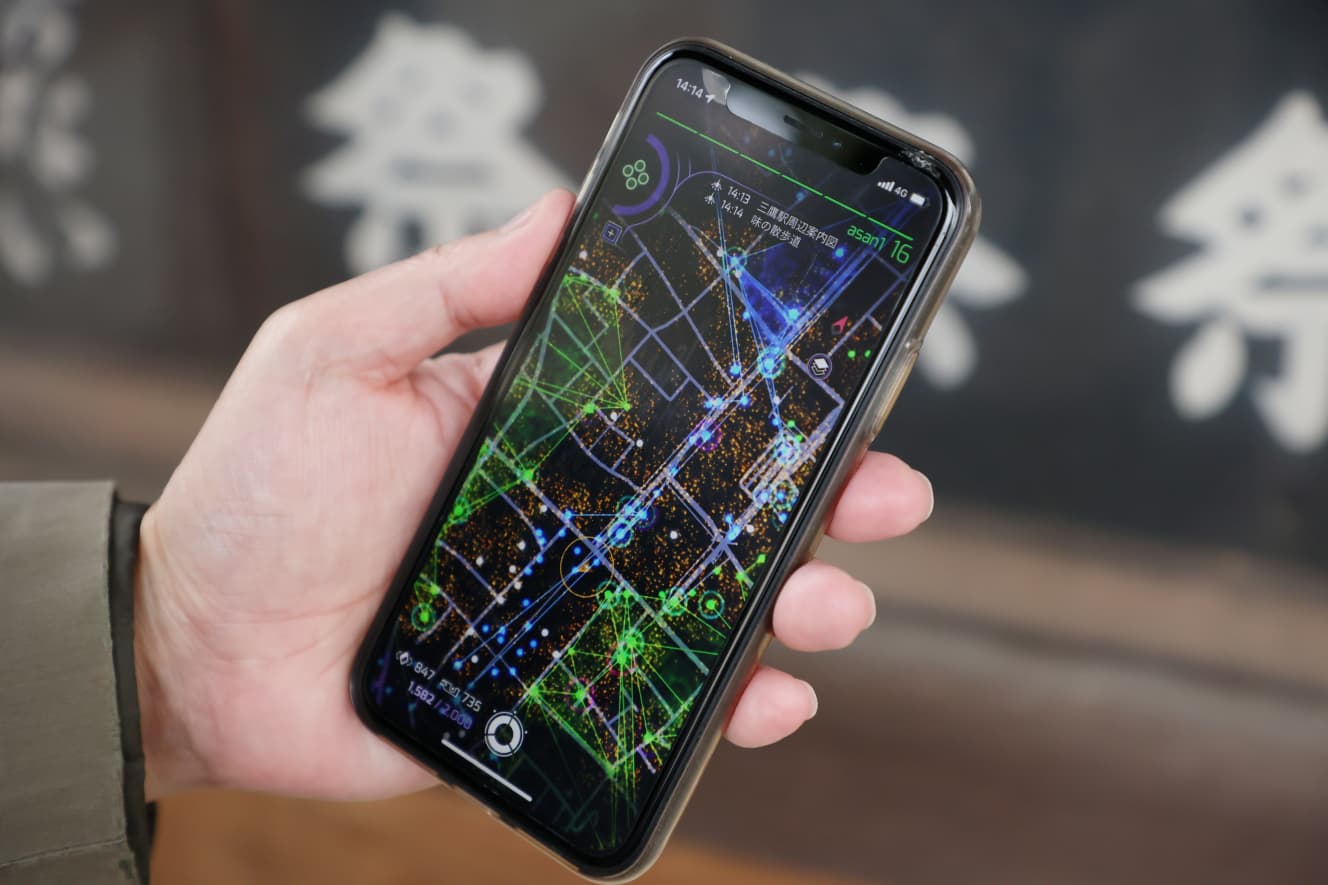
─ In other words, the map book painting was realized in conjunction with “Ingress”. Ingress” was officially launched in 2013, so Mr. Asano, who was born in 1962, would have been about 50 years old then. It’s hot that mapbook painting, which had been sealed off because no rules could be found, has been realized after about 30 years.
Asano: In “Ingress,” when you advance to level 8, all you can do is increase the amount of things and nothing new happens. I thought that would be a bit boring after all the excitement and fun I’ve had playing the game up to this point. When I thought about how I could continue to have fun, I remembered my ambition to walk all over Tokyo when I was in my 20s (laughs).
(laughs) ─ ─ I see what you mean!
Amano: The portals in “Ingress” cover the most famous places in the area, so I realized that by hacking (*getting to the location in the game), I could go there. The game covers all the topics of the place, such as Jizo-san (a Buddhist statue) and unusual signboards in the shopping district.
─ ─ Then why not just use “Ingress” (laughs)?
Asano: No, that’s right. If “Ingress” could record whether or not a user visited a particular portal, then “Ingress” alone would be sufficient. I don’t know about now, but at that time it wasn’t possible. I visited about 50,000 portals, but I couldn’t see them in the “Ingress” app. So, I started to map the places I visited on a map book. So, if you look at this map book, you will know that you have seen everything of interest in the area. Is this the …… collection?
─ ─ A fine collection! Ingress” is not a game that aims to paint maps, so it does not have such a system, but “Mapbook Painting” was created in conjunction with “Ingress,” and “Tec-Tec Life” is a sublimation of that as a location-based game.
The map book is backed up.
So, we arrived at Okunitama Shrine. We hacked several portals to get here. I see that the Ootorii gate of the shrine is also a portal.
Asano: After hacking a few portals, I painted the same area in the map book.
─ ─ You used a green marker to fill in the area, but perhaps the reason you chose that color is because of …….
Asano: Because I am an enlisted man in “Ingress.
─ ─ I knew it! I had a sneaking suspicion that wasn’t the case (laughs).
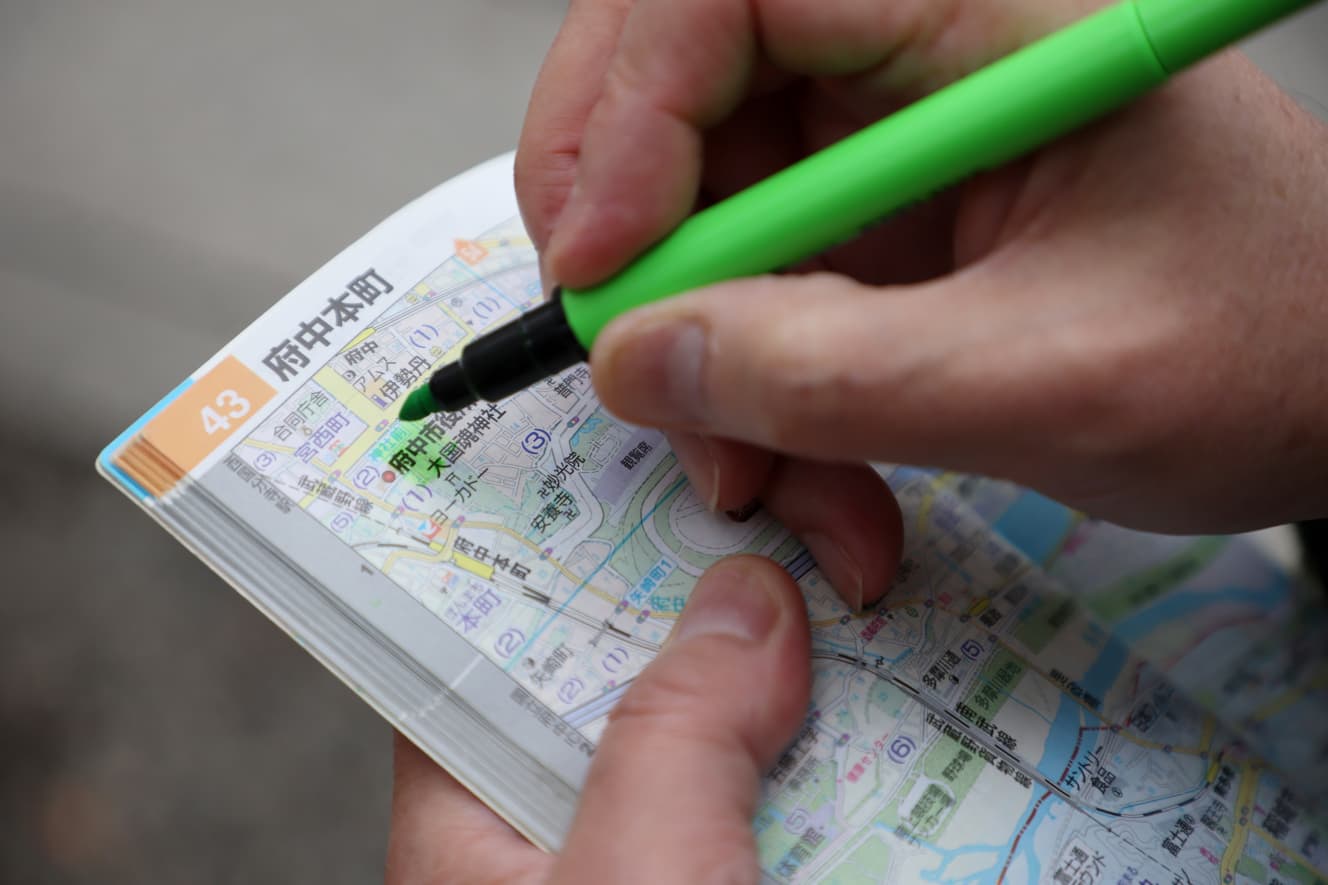
Asano: So, this is the actual map book I am painting on, and I have four or five copies at home.
Hm…? If it were Tokyo, wouldn’t two books be enough, one for the 23 wards and one for the Tama area?
Asano: Why, because you have to have a spare. Once, I left it in the restroom of Maruzen in Nihonbashi, and when I rushed back to get it, it was still there, so I was saved, but at that time I thought, “It would be bad if I lose it someday,” so I have several copies (reproductions painted in the same way).
─ ─ I have backups. Besides, I think map books get damaged when you carry them around every day.
Asano: In fact, they are falling apart, and in summer they smell sweaty (laughs).
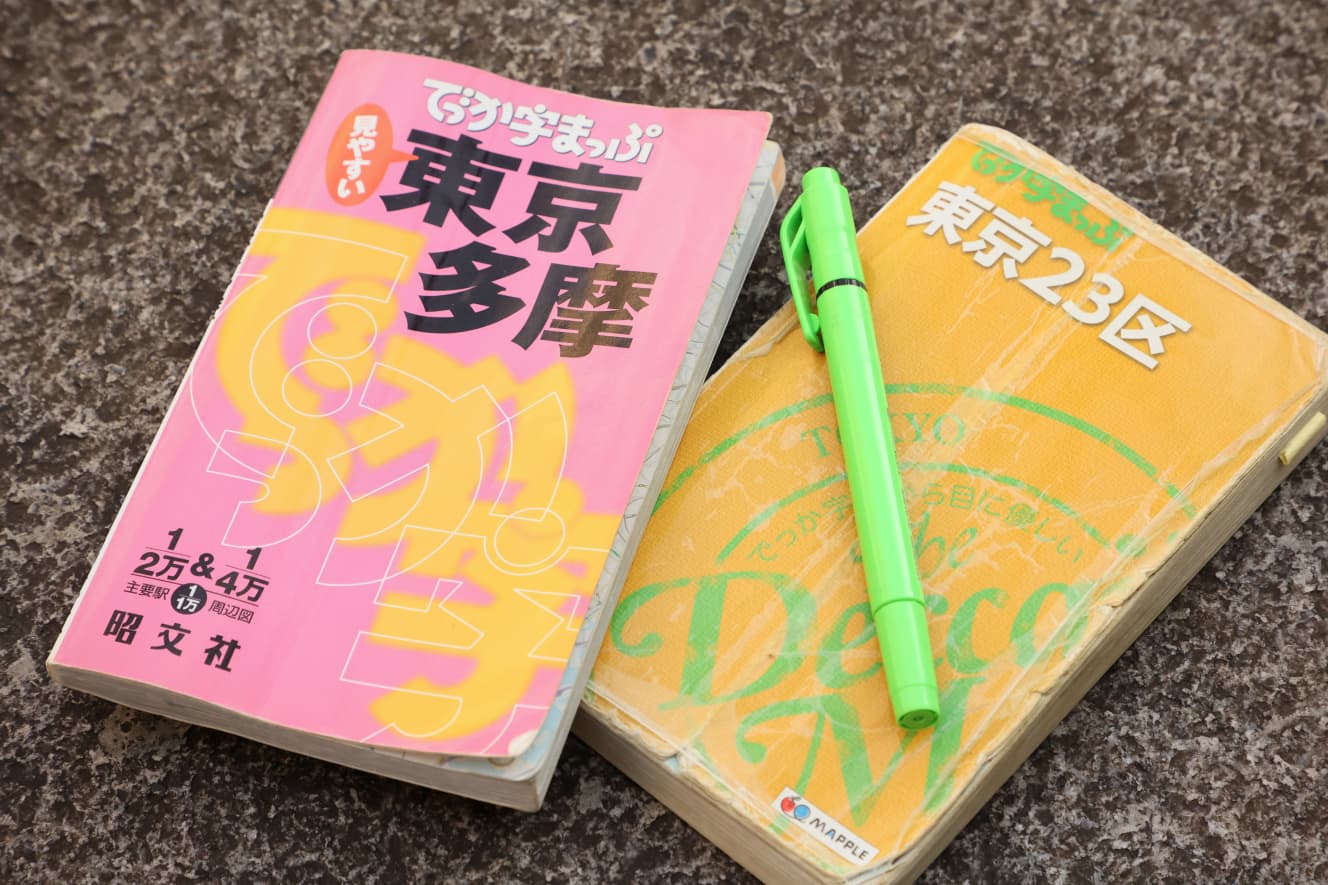
─ But then, Mr. Asano, you must be quite busy playing “Ingress” and painting the map book when you travel, mustn’t you?
Asano: No, not really, since I have already painted all 23 wards and am not playing “Ingress” anymore. These days, I only play “Tech Life,” “Pokemon Go” and “Pikmin Bloom” for research.
─ ─ Even so, I’m still busy (laughs). I mean, you’re still playing “Tec-Tech Life,” right?
Asano: I still have a lot of work to do in the 23 wards.
─ ─ Even you, Mr. Asano, the developer, have a lot of work left to do?
Asano: Well, it’s the second round, so my motivation is low.
─ ─ By “second round,” you mean that “Tec-Tec Life” is now in its second round?
Asano No, I already circled the 23 wards of Tokyo once when I was playing “Ingress,” so this is the second time I’m going around the city for “Tec-Tec Life.
Ah, so that’s how it is (laughs). (laughs) Is there anyone who has filled 100% of Japan with “Tec-Tec Life”?
Amano: No, I haven’t. I saw a person who said the highest percentage was 26% the other day.
─ Oh, I didn’t know that was the case. But, I see. Even I am at 1%.
Amano: Tokyo is, after all, one of the smallest prefectures in Japan. Even in Tokyo, it is probably impossible to paint 100 percent.
─ Can’t I just use Tonari-nuri (*You can paint the area next to a district that you have actually crossed without going that far if you spend TTP points)?
Asano: It can be done in Tokyo. But not for the whole of Japan.
I like maps because of “Dracula
─ ─ I would like to know the background of your desire to paint maps.
Asano: My desire to paint maps came from an urge I had when I was 20 years old to “walk all over Tokyo. As I said at the beginning, it was an extension of the feeling of traveling. When you go on a trip, you want to see everything you can find. Coming here from Kansai, I want to see all of Tokyo. But I didn’t know what constituted “everything.
─ ─ I think it is strange or interesting that this leads to the action of recording it in the form of “painting a map. Were you a child who liked looking at maps from a young age?
Asano: No, no, no, geography was my worst subject. My grades were not that bad, but in junior high school I got a 7 or so in geography, which was stupid. But strangely enough, even though I hated geography and social studies, I found myself holding a social studies teacher’s certificate.
I was a bad geographer. Before I knew it, I was making map games (laughs).
Asano: I always hated maps, but I came to like them because of “Dracula. After all, “Dracula” is a game in which you travel around on a map, isn’t it?
─ ─ You are right.
Asano Nowadays, “Dracula” has a 3D map, but originally you were moving around on a 2D map. That’s how I fell in love with maps. When I joined Chunsoft, I would show President Koichi Nakamura the RPG maps I had drawn, as if I had some kind of chuuni-sickness.
─ But I understand how you feel. I feel the same way.
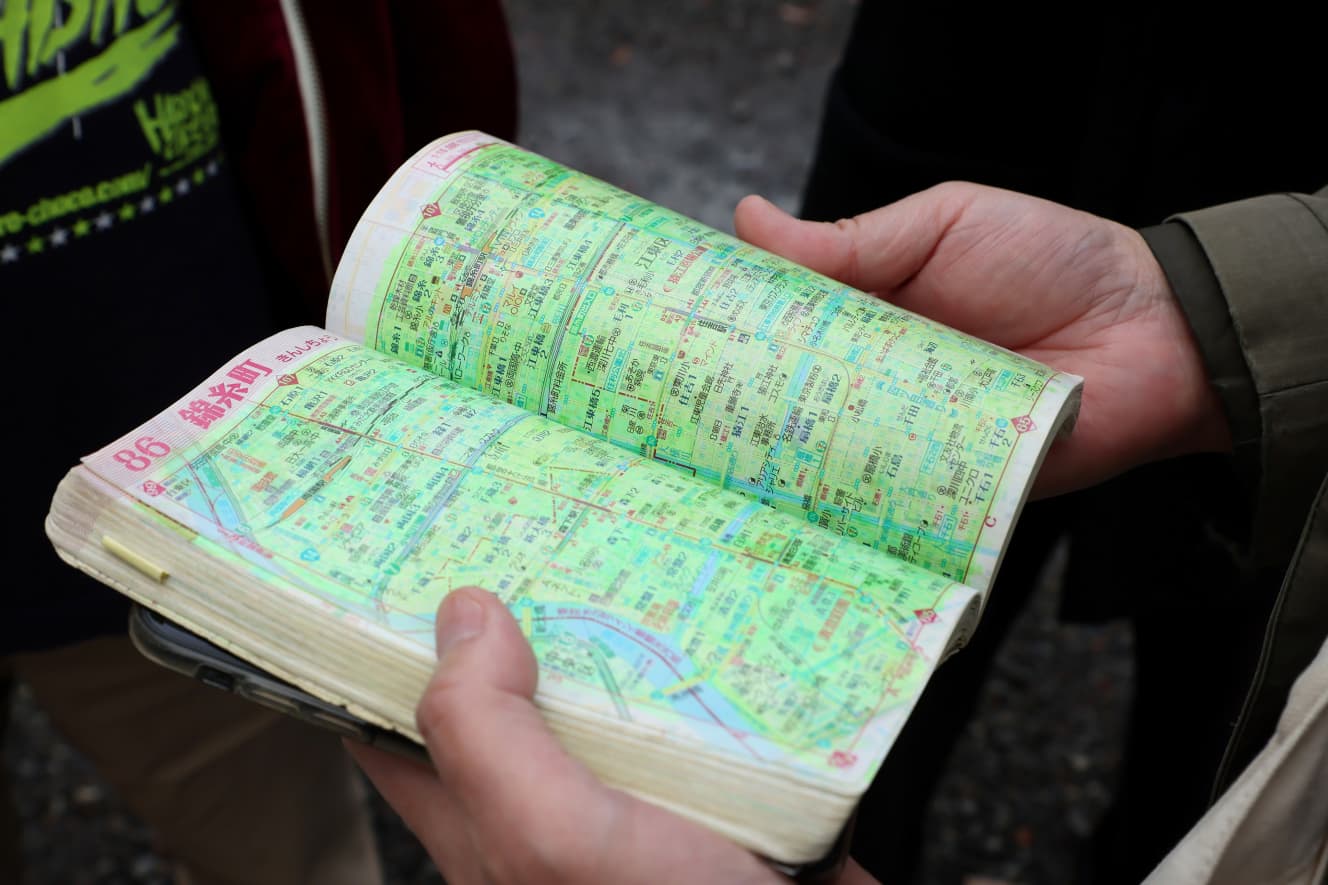
Asano: So, how long would it take to walk the entire 23 wards of Tokyo? And if I went around all of them, what would I be able to see? What can we gain from this? I thought, “What if I could do that? But surprisingly, I didn’t (laughs). The best byproduct was the creation of “Tec-Tec Life.
─ ─ That was a great accomplishment!
Asano: When I started painting the map book, I did not know how long it would take. As expected, I didn’t think it would only take one or two years, but I had no idea if it would take four or five years, or if it would still be a long process even after 10 years.
─ So you couldn’t see the balance of the game?
Asano: Yes. However, when I went to work or a meeting, I would go early and paint before the appointed time, or on my days off, I would get up early and go out and paint a little further, and I began to see that I could conquer the 23 wards in about a year. I thought I could do it in five or six years, and that’s actually how it went. And, well, I did have some flirtations along the way, visiting places outside the 23 wards, such as Mitaka and Yokohama, but I figured that if I could enjoy it as a hobby for 5-6 years, it would be affordable.
───Mr. Asano, you left Chunsoft in 2002, so you were a freelance cartographer when you started painting maps, right?
Asano: Yes. I feel that it would take more time for someone who goes to the office at 9:00 and 5:00.
I’m interested in things like trivia about the city.
─ ─ Have you ever encountered any danger while filling out the map book?
Asano: Fortunately, there has been no trouble that seems to be trouble. However, it is dangerous along the Gulf Coast, isn’t it? It’s not a place for people to walk. There are big trucks and other things going by, and there are no sidewalks that look like sidewalks, so it’s very scary.
─ ─ Indeed, the industrial road is scary. So, what was interesting about the industrial road?
Asano: There are places that are interesting or taboo, such as the Imperial Palace, of course, and places related to the Imperial Family. Also, the Self-Defense Forces and the U.S. military. These are facilities that are off-limits to the general public. And women’s colleges.
Ah!
Asano: There are some women’s colleges that are more lenient and some that are more strict about entry, such as XX Women’s University (*name withheld). However, the so-called “lady’s schools” are not allowed to enter at all. As soon as you try to enter, they ask, “What do you want? The security guards would come to me and say, “We’re here to help you. And when I said, “We have a famous stone monument that we would like to visit,” they refused, saying that I had to get permission.
─ Well, there are people who do bad things in the world.

Asano: Well, there is a place called Showa-jima Island, south of the distribution center on Heiwajima, which is not usually visited, but there is a place to live and some stores. But there are places to live and even a few shops. So there are so many different parts of Tokyo.
─ ─ Are there areas that are unusually sparsely populated or, on the contrary, densely populated?
Asano: There is a mammoth housing complex in Shinagawa called Shinagawa Yashio Park Town. I was very surprised when I visited there. It was an incredibly huge apartment complex. If I had been born and raised there, I felt that there was something special about the area, as if I had been born and raised there, I felt that I would have developed a kind of disposition that was unique to that place. It was interesting to discover such things.
─ ─ Regarding housing complexes, the Danchidan (a unit consisting of members from different professions such as editors, scriptwriters, and writers) discusses urban and cultural theory from the perspective of housing complexes, don’t they?
Asano: Another interesting thing was a place called Hanahata in Adachi-ku, where there are memorial parks and stone monuments here and there commemorating the land readjustment. When I visited there 5 or 6 years ago, I found them and thought, “I see,” but at that time, a huge area in front of the station was under construction. When I saw it, I remembered that before Roppongi Hills was built, they were bulldozing the whole town of Roppongi, and I thought that maybe they were going to build a big condominium or shopping mall in that area.
─ That’s what community redevelopment is for, isn’t it?
Asano: However, the last time I went there for the first time in a long time, I saw ordinary one-story houses. I thought, “What? I thought to myself, “What the heck is this? When I looked at the sign, it said “The XXth Rezoning” and they are rezoning again. The reason for this is that there used to be many rice paddies in the past, so the paths between rice paddies used to dead end or meander in strange ways, so they were broken down and made into a grid. We have been doing that for a long time. I have never seen such a town in all of Tokyo.
─ Adachi Ward is quite large, isn’t it?
Asano It is a big place. It’s probably next to Ota and Setagaya wards. Adachi Ward is now served by the Nippori-Toneri Liner, but to be honest, there is no railroad that is really a railroad, so the area that can only be reached on foot is too large. I think it is very difficult for the residents.
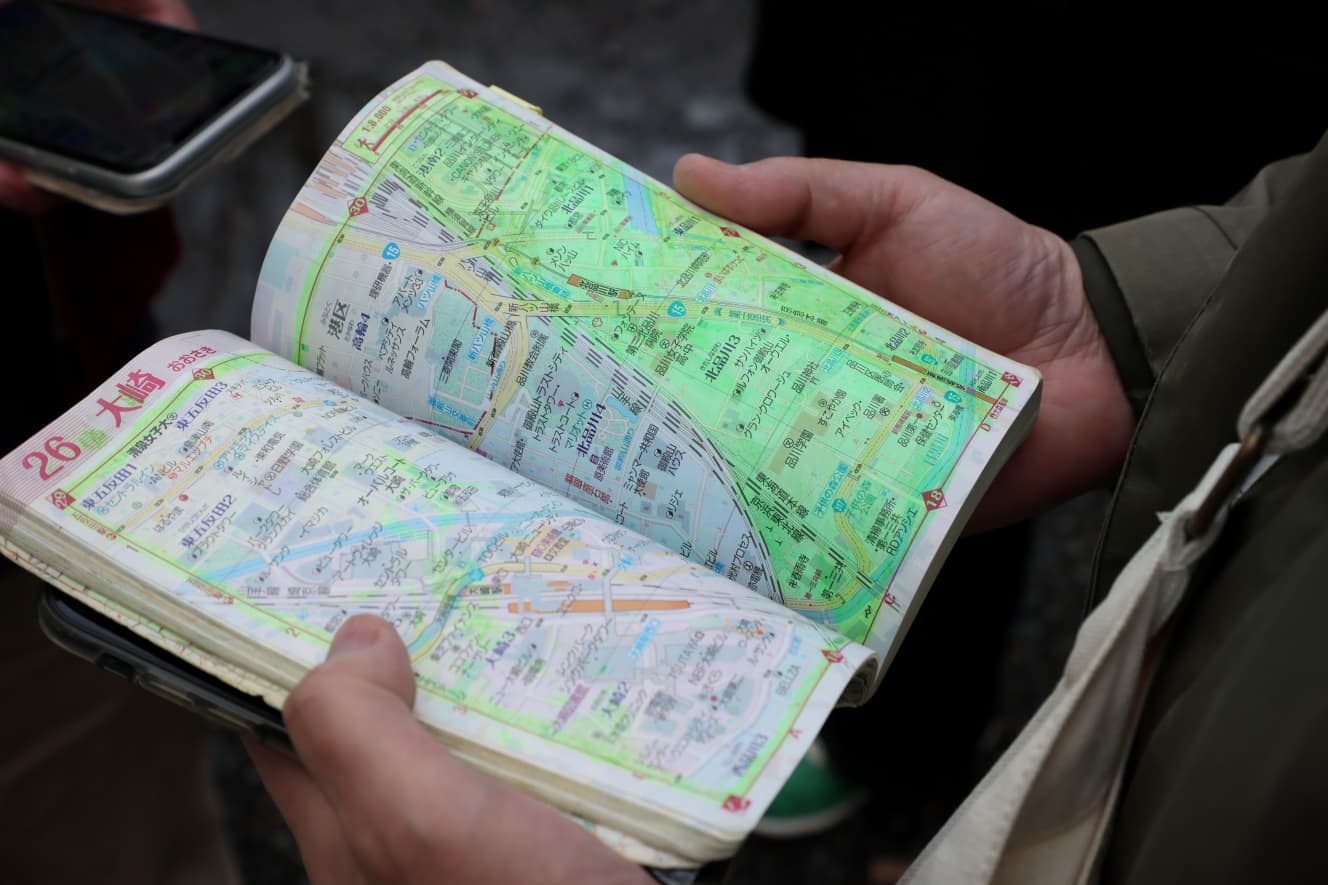
─ ─ You said that you did not gain anything by walking through all of Tokyo’s 23 wards, but there are quite a lot of discoveries.
Asano: That may be so. There is Oizumi-Gakuen, isn’t there? There is a station and a town with that name, but there is no school called Oizumi Gakuen there.
─ Ah ha, indeed.
Usually, there is a school called Oizumi Gakuen in towns with school names such as Tokyo Metropolitan University or Gakugei Daigaku. They have moved now, but there used to be a school there. When I went to Oizumigakuen, I looked for it for a long time, but not only had it moved, it was not there from the beginning. I looked up the origin of the name, and found that there were plans to invite a school to the area, so the name was given to the town and the station, but they were unable to attract the school, so only the name remained as a phantom school. There is an Oizumi Gakuen Elementary School, but it was named after a public school that was established in the town of Oizumi Gakuen, and it has nothing to do with the original Oizumi Gakuen.
───That’s complicated.
Asano Another interesting point is that Arakawa Ward does not border the Arakawa River at all. I think the Arakawa River probably moved there for irrigation or something in the past.
Ah, yes, that’s right! It is blocked by the Sumida River, isn’t it?
Amano: I am always interested in trivia like that. There are many stations that I would never go to if I didn’t paint the map. Horikiri-Shobuen, for example. I had no connection to such places.
─ ─ Freelancers tend to go everywhere, but even so, there are limits.
After painting the 23 wards of Tokyo, I went on to ……
───I’m asking you, Mr. Asano, do you have a collector’s nature?
Asano: Not at all. Not at all.
─ That is surprising. Looking at the games you have made so far, I had the impression that you were someone with a strong disposition toward such things.
Asano: Not at all. When I was in elementary school, there was a stamp-collecting boom, and I did get in on the fad, but it was only for a moment. I also wanted to collect Kamen Rider cards, of course, but I couldn’t spend enough money to complete the collection, and when I became an adult and was able to spend money more freely, I already knew that I was not a collector at all.
─ Then, is there anything else that you are collecting at the moment?
Asano: No. Well, when I play a game, I finish it as soon as I reach the ending. I don’t care if there are weapons I missed out on or sub-scenarios I haven’t seen yet (laughs). I keep all my game consoles because it’s my job, but I don’t collect them, so there are a lot of them I don’t have. Like the Jaguar.
─ I don’t think you need to have a Jaguar (laughs).
Asano: What was the name of the PR person who used to work for Sega?
─ ─ Mr. Tadashi Takezaki (*current president of Toms Entertainment).
Asano: Yes, yes, Mr. Takezaki has all the Mega Drive software and such, don’t you? I think it is his love for Sega. I don’t have a collection in that sense.
─ ─ It is interesting that such a person thought it would be fun to play a game where you keep filling in the map.
Amano No, I didn’t think it should be interesting. I just wanted to continue enjoying “Ingress. I am a person who loves to walk a lot, and I love to go outside. That’s why my favorite game is “Civilization,” in which you build up a civilization.
─ Ah, I only know the title of the game. Is it a simulation?
Amano: For example, if I were in Japan, I could be Nobunaga Oda, symbolically spreading Japanese civilization, or Queen Elizabeth, spreading British civilization, etc. But what you do is just stand there with your soldiers in a completely empty space. As you walk along, the view gets better and better, and you start to see things like, “This is flat land,” or “This is a mountain,” and eventually you run into an enemy wall, which creates a border line, and you fight to expand your territory.
In other words, there are many elements to the game, but finding and expanding your territory is fun, and you can do it yourself with a map, or, to put it another way, when you think that the area you have visited and painted is your territory, it satisfies your desire for conquest. It’s not so much a collection as a desire to conquer.
I see. But the desire to collect and the desire to conquer are very close.
Asano: That’s what makes me feel good, and in fact, places I’ve never been to before are somehow new to me. No matter how boring it is. I see that even in such an upscale residential area, there are trashy places. Or vice versa. What’s that? I wondered if there were places like this in Shirokane (laughs).
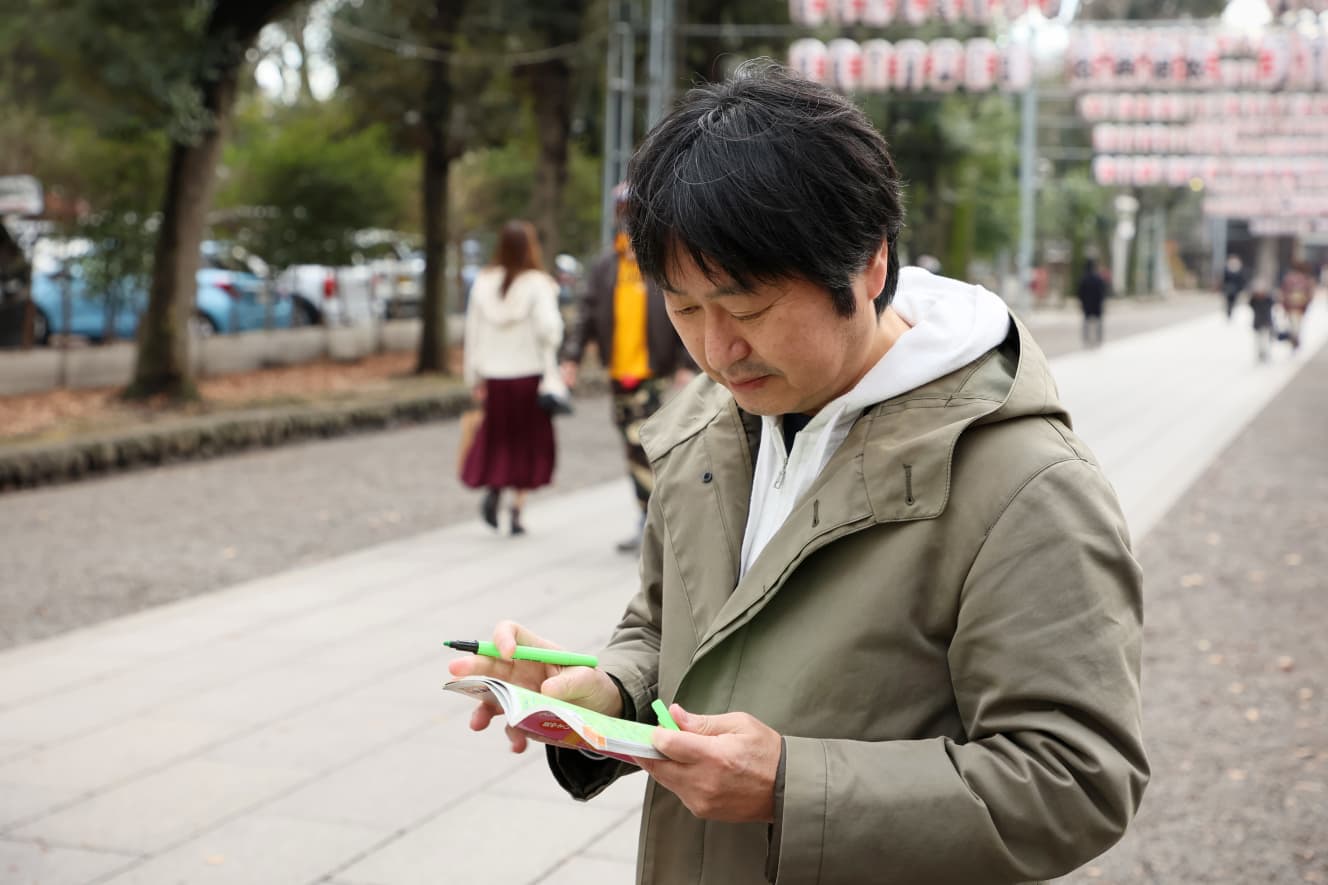
─ ─ Just as it is very difficult to achieve 100% in “Tec-Tec Life,” there is no end to the fun of painting a map book. Will you continue to paint for a while longer?
Asano: Well, yes. If I don’t change my axis a little, I won’t be able to do anything else. I have been keeping a reading log since I was about 30 years old. When I was in my 40s, I was reading about 10 books a month, but since I turned 50 and started walking, the amount I read has dropped dramatically. I’ve also lost most of my other hobbies, such as going to the movies or going to see a play. After all, I spent the first half of my 50s walking almost every day.
─ ─ I also had to make inputs for my work.
Asano: So, even if I walked one day on either Saturday or Sunday, I would have to limit it to once a week on weekdays at the most. Also, when I was doing it alone, I had a strange self-consciousness, a sense of pride or a secret pleasure that I was the only one in the world doing such a stupid thing, but now everyone is doing it for me (“Tec-Tec Life”).
(laughs) ─ So you don’t have that kind of self-consciousness anymore.
Asano: I think the biggest thing was the sense of accomplishment I got after painting the 23 wards of Tokyo. Of course, there are areas that are off-limits without permission, but I went to all the places I could go.
(After the interview)
Before the interview, I had imagined that Mr. Asano would come to Tokyo, decide he wanted to walk all over Tokyo, fill out a map book on foot, and use that as inspiration to invent the “Tec-Tec Life”! That was the story. There was no doubt that painting the map book was the basis of the “tech life” project, but the influence of “Ingress” was greater than I had expected. I was amused and deeply convinced by the fact that the color of the markers used to paint the map was Enlightened-derived green.
(This series will be updated on the first Friday of every month. The next installment is scheduled for April 1. Please look forward to it!)
Interviewed and written by: Akihito Tomisawa
A self-proclaimed professional collector who continues to study the ecology of people obsessed with collecting. He is the author of "Bottomless! The World of Big League Cards" (Sairyusha), "Hitokui Eiga Matsuri" (Tatsumi Shuppan), "MUGEN no Hondana" (Chikuma Shobo), "Record Koshi no Sengo Shi" (P-VINE), and other books are all related to collecting. His latest book is "Yusha to Tank to Monster 1978~2018☆Boku no Game 40-nen History" (Komakusa Shuppan), in which he looks back on his own relationship with video games.
Photography: Katsumi Murata
